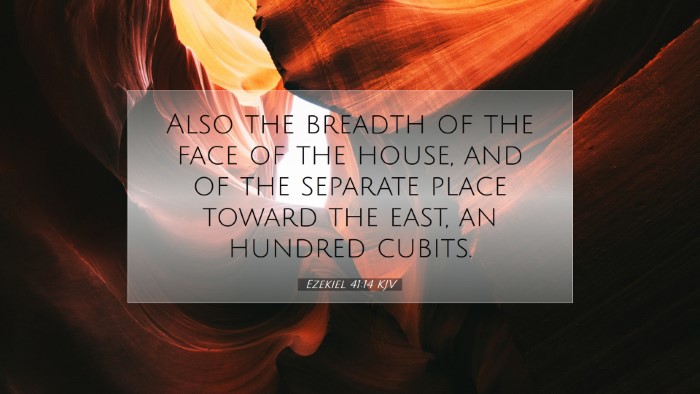Ezekiel 41:14 Commentary
"So the width of the inner court was twenty cubits, and the length of the court was the same as the width of the outer court."
The architectural details provided in Ezekiel 41 are rich in symbolism and significance, reflecting both the nature of the Temple and the spiritual realities it embodies. The verse we focus on deals with the measurements of the courts, which are crucial for understanding the overall structure and its implications.
Contextual Overview
The Book of Ezekiel is a prophetic work that encompasses themes of judgment, restoration, and hope. Written during the Babylonian exile, Ezekiel’s prophecies include vivid visions and detailed descriptions of the future temple. In Ezekiel 41, the prophet is given a vision of a restored temple and its subsequent measurements, intended to convey the grandeur and holiness of God’s dwelling among His people.
Insights from Public Domain Commentaries
Matthew Henry's Commentary
Matthew Henry highlights that the measurements of the temple serve as a reminder of God’s order and majesty. The precision with which Ezekiel describes the dimensions shows a divine design in worship, reflecting God's holiness and the need for proper reverence in approaching Him.
- Henry notes that the inner court represents a closer intimacy with God, contrasting with the outer court which is more accessible.
- He emphasizes the spiritual implication of the dimensions: just as a specific measure is required in the physical space, so must there be a true measure of holiness and purity within the hearts of the worshippers.
Albert Barnes' Notes on the Bible
Albert Barnes provides a detailed exegesis of the text, stating that the verse emphasizes the significance of the inner court's broader width compared to the outer court. This spatial distinction serves to portray the differing levels of sanctity and access to God's presence.
- Barnes points out that the width of the inner court signifies the abundance of grace available to those who draw near to God.
- He also connects the dimensions with the principles of New Testament access to God through Christ, illustrating a continuity from the Old Covenant to the New Covenant.
Adam Clarke's Commentary
Adam Clarke focuses on the typological significance of the Temple’s structure. He suggests that the inner court's configuration foreshadows the New Testament church, which is built on the foundation of the apostles and prophets, where Jesus Christ is the chief cornerstone.
- Clarke explains that the dimensions of the courts symbolize the relationship between God and His people, encouraging believers to recognize their access to God's holiness through sincere worship.
- He also draws parallels with the descriptions of Heaven, noting that just as physical dimensions are given for earthly worship, a spiritual reality awaits in the eternal dwelling place of God.
Theological Implications
The measurements given in Ezekiel 41:14 hold several theological implications, which can be unpacked as follows:
- God's Sovereignty: The specificity of the measurements reflects God's sovereign design and purpose in both the Temple and the lives of believers.
- Access to God: The distinction between the inner and outer courts teaches about the varying levels of access to God, reminiscent of the progression from the outer courts to the Holy of Holies.
- Holiness and Worship: The care in architectural details stresses the importance of holiness in worship, reminding modern believers of the call to be holy as God is holy.
Practical Applications
For pastors, students, and scholars, reflecting on this verse and its commentary leads to practical applications:
- Intentional Worship: Consider how worship practices can reflect the holiness of God and encourage congregations to approach Him with reverence.
- Spatial Awareness in Ministry: Recognize how spaces dedicated to worship can shape the worship experience, influencing the spiritual atmosphere and congregational behavior.
- Spiritual Growth: Encourage believers to seek a deeper relationship with God, looking to move from the outer courts into a more intimate fellowship with Him demonstrated in the inner court.
Conclusion
Ezekiel 41:14 provides a rich tapestry of insights into the nature of God’s dwelling place and the architecture of worship. By examining the thoughts from Matthew Henry, Albert Barnes, and Adam Clarke, readers can appreciate the historical, spiritual, and theological layers of meaning within this passage. The dimensions are not merely measurements; they illustrate the divine order placed within the context of worship, urging modern believers to contemplate their approach to God and the significance of holiness and reverence in their lives.


